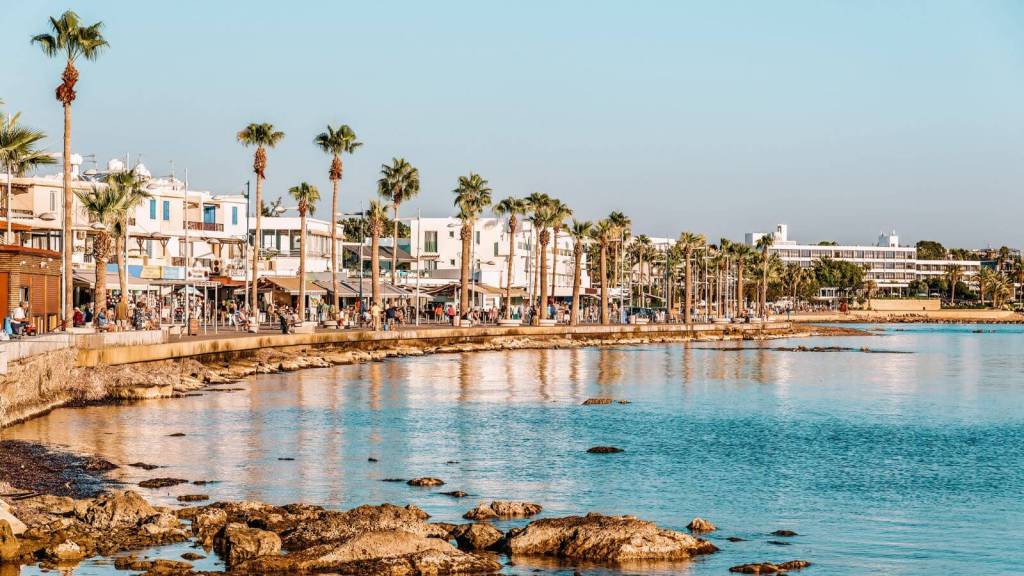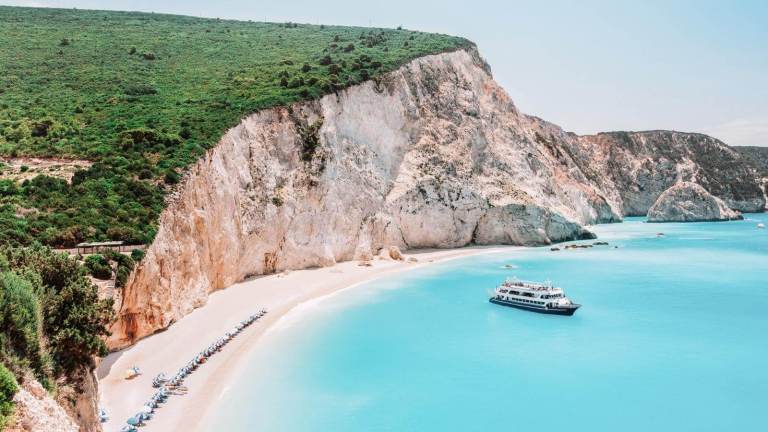12 Hottest Countries in Europe for Endless Sunshine
Some of the links might be affiliate links and, at no extra cost to you, we earn a small commission. See our disclaimer for more info.
Are you looking for hot countries to escape to in Europe? Whether you want a coastal escape even in winter or are looking for a hot country to move to or retire in, there is something for you in Europe.
While some areas of these countries can get uncomfortably hot in summer, the good side is that they typically remain pleasantly warm even in winter or autumn. For this reason, savvy travelers choose to skip the summer crowds, the sweltering temperatures, and the high prices and visit during the low season in autumn and winter, many of which remain pleasant for outdoor exploration.
Whether you are after a beach holiday or just looking to escape the cold of winter, you will get your dose of warmth in these countries.
Spain

Spain’s climate varies greatly, but most of it is influenced by the Mediterranean weather, especially in its eastern and southern coastal areas.
Daytime summer temperatures typically go above 86°F (30°C), making it perfect for spending your day soaking up in the country’s beaches.
🏨 Explore all your hotel options here
The typical autumnal temperatures range from 59°F to 77°F (15°C to 25°C) in many coastal areas, though they can be cooler in northern regions and at higher altitudes. If you are looking for a hot beach escape, especially in autumn, you may want to consider the Canary Islands, such as Tenerife and Gran Canaria, which experience days of sunshine even in winter.
The Costa del Sol region, especially Malaga and Marella, or the Balearic Islands like Mallorca, Menorca, and Ibiza, are also great hot destinations to escape cold weather in the rest of Europe.
Read also: Hidden Beaches in Europe
Greece

Greece is a great place to consider if you are looking for a hot escape at the peak of autumn or winter. Whether you are visiting Athens or one of its numerous islands, you will benefit from its southern location and Mediterranean climate.
🏨 Explore all your hotel options here
Summer daytime temperatures may reach 95°F (35 °C) but typically settle at around 77°F (25 °C) in the evenings. In autumn, temperatures in Greece range between 59°F and 77°F (15°C to 25°C), depending on the specific region and month. Winter temperatures remain in the range of 8°C to 15°C (46°F to 59°F) in most areas, which is still pretty decent for outdoor exploration.
With these temperatures, you can comfortably Visit Athens, Santorini, Rhodes, or other Greek islands for a warm coastal escape, even when the rest of Europe is freezing.
Read also: Best European Beaches
Italy

Italy enjoys a diverse climate, with Mediterranean conditions prevalent along the coasts and southern regions. Italian summers, especially in the south, can get very hot. Depending on your location, summer temperatures play in the range of 64.4°C to 100.4°F(18°C and 38°C).
🏨 Explore all your hotel options here
Autumn temperatures in Italy typically range from 50°F to 68°F (10°C to 20°C ) in many regions, which is still decent enough for holidays and even beach vacations.
If you are looking for hot destinations to try even in winter and autumn, your best bet would be along the Amalfi Coast, Sicily, or Sardinia. These destinations experience plenty of sunshine, even in winter and autumn.
Read also: Bucket-List Worthy European Destinations
France

France is a land of diverse landscapes, including mountains, valleys, and coastlines. With varied landscapes come diverse climatic conditions. For example, some areas, like the French Alps, are typically very cold and experience snowfall. That being said, southern France and coastal areas tend to be warmer, while northern regions typically experience cooler temperatures. Autumn temperatures in France usually range from 50°F to 68°F (10°C to 20°C ) in many areas.
Summer temperatures in the Northern region down to around the center of the country range from (60.8° F to 75.2°F) 16°C to 24°C, while temperatures in the southern and eastern parts of the country range between 60.8° F to 86°F (24°C to 30°C).
🏨 Explore all your hotel options here
Regions like the French Riviera (Côte d’Azur), Provence, and Corsica experience very hot summers, pleasant autumns, and mild winters. These three regions make for very perfect destinations for winter and autumnal escapes.
Looking for warm cities to tour? Consider Nice, Cannes, Saint-Tropez, and the French Riviera, which have consistently warmer temperatures even in winter.
Read also: Hidden European Gems
Cyprus

Cyprus is located in the Eastern Mediterranean, and its climate is characterized by mild, wet winters and hot, dry summers. The island’s proximity to the Mediterranean Sea helps moderate temperatures, keeping winters relatively warm.
Autumn temperatures in Cyprus typically range from 68°F to 77°F (20°C to 25°C) in many areas. Autumn is a pleasant time to visit the country and enjoy different outdoor activities.
🏨 Explore all your hotel options here
On the other hand, summer in Cyprus can get hot , with temperatures ranging from 95 °C (35 °C) during the day and around 77 °F (25 °C) during the night.
If you want hot temperatures even in winter, excellent destinations to consider in Cyprus include Limassol, Paphos, or Larnaca, all of which offer amazing coastal escapes.
Read also: Romantic European Destinations
Malta

Valletta, the capital of Malta, receives an annual average temperature of 72.4 º F (22.3ºC). Any time of the year is always a good time to visit Valletta.
Malta is in the central Mediterranean and has a subtropical climate known for its hot, dry summers and mild, wet winters. The island experiences sunshine throughout the year, making it an attractive destination for visitors seeking warmth even in autumn and winter.
🏨 Explore all your hotel options here
Average summer temperatures remain around 71.6°F to 87.8°F(22°C and 31°C). Autumn temperatures range between 68°F to 77°F (20°C to 25°C), making it ideal for exploration, especially when the rest of Europe is getting colder.
Besides Valletta, you can visit all-year-round hot destinations in Malta, including Sliema on the Northeastern coast of Malta and Mellieha, located on the northern part and known for its sandy beaches, including Mellieha Bay and Golden Bay.
Read also: Best Value Beach Destinations in Europe
Portugal

Portugal is located in Southwestern Europe, and its south and central regions experience a Mediterranean climate. The summers are typically very hot and dry, while the winters remain comfortably mild.
The height of summer in Portugal sees temperatures as high as 84.2°F (29 °C). However, the country’s average for the entire season is usually around 78.8 °F (26 °C).
The winter temperatures range between 50°F to 59°F (10°C to 15°C) in coastal areas, while inland temperatures may be cooler. Cool, yes, but it’s still modest enough for exploration.
🏨 Explore all your hotel options here
The southernmost region, the Algarve, is known to experience warm weather all year round. If you are looking for destinations you can visit all year round, consider Faro, Albufeira, and Lagos, as they experience very mild winters and plenty of sunshine.
Lisbon, Portugal’s capital, enjoys a mild climate even in winter, making it a year-round destination. If you are into island life, consider exploring the Madeira archipelago, which offers fantastic coastal escapes.
Read also: Top Greek Islands for Beaches
Croatia

Croatia is one of the warmest countries in Europe, thanks to the Mediterranean conditions along its coastline, which somehow neutralizes the continental climate in its interior regions. The coastal areas, including the Dalmatian coast, benefit from their location on the Adriatic Sea, which helps moderate temperatures and keeps winters relatively mild.
Summer temperatures range on average from 78.8°F to 86°F (26°C to 30°C) on the country’s coastline, 71.6°F to 78.8°F (22°C to 26°C ) in the continental region, and 59°F to 68°F (15°C to 20°C) in the mountain regions.
🏨 Explore all your hotel options here
Autumn temperatures in Croatia typically range from 50°F to 68°F ( 10°C to 20°C) in many coastal areas, with warmer temperatures in the south. Inland regions may experience slightly cooler temperatures but generally remain comfortable for outdoor activities.
If you are looking for the perfect destination to escape to, consider Dubrovnik, Split or Hvar. These destinations offer numerous outdoor exploration opportunities, even in autumn or winter.
Read also: European Cities With Great Cultural Heritage
Albania

Located in the Balkan Peninsula, the country’s proximity to the Mediterranean is the reason behind its mild winters and hot summers; autumns remain pleasantly warm, in the ranges of 50°F to 68°F (10°C to 20°C ) along the coast, with warmer temperatures in the south. While the inland temperatures may be cooler, the country generally remains warm for many outdoor activities.
🏨 Explore all your hotel options here
Summers in Albania can get hot, with temperatures as high as 91 °F (33 °C) experienced at the season’s height.
If you are looking for a hot destination, Albania’s coastal towns of Saranda, Durres, and Vlora remain pleasantly warm for coastal escapes.
Read also: Quick City Getaways in Europe
Montenegro

Montenegro’s warm weather can be attributed to its location on the Adriatic coast. The country’s temperatures are primarily influenced by the sea. Autumn temperatures in Montenegro typically range from 50°F to 68°F (10°C to 20°C) along the coast, with warmer temperatures in the south.
🏨 Explore all your hotel options here
Summer temperatures vary greatly, from 68°F to 102.2° F (20°C to 39°C), depending on region
Some of the best destinations for sunseekers include Kotor and Herceg Novi, located on the picturesque Bay of Kotor, and Budva, known for its stunning beaches.
Read also: Fairytale Towns in Europe
Bulgaria

Bulgaria’s climate varies depending on the region, but much of the country benefits from its location in southeastern Europe and proximity to the Black Sea. Coastal areas experience a Mediterranean climate with mild, wet winters and hot, dry summers, while inland regions have a continental climate with colder winters.
Summer temperatures in Bulgaria hover in the range of 77°F to 86°F (25°C to 30°C).
🏨 Explore all your hotel options here
Autumn temperatures hover in the range of 41°F to 59°F (5°C to 15°C) in many areas, which is way hotter than many regions in Europe. If you are looking to escape frigid temperatures from other places in Europe, some Bulgarian destinations include Varna, Burgas and Plovdiv, which remain pleasantly warm and manageable even in the peak of winter.
Read also: Underrated Places to Visit in Europe
Turkey

Turkey, located at the crossroads of Asia and Europe, benefits mainly from its extensive coastlines on the Mediterranean, Aegean, and Black Seas. The coastal regions remain pleasantly warm in autumn and winter. Autumn temperatures range from 59°F to 77°F (15°C to 25°C) in coastal areas, with warmer temperatures in the south.
🏨 Explore all your hotel options here
The summer temperatures play in the range of 77°F – 86°F (25 °C and 30°C)
If you are looking for warmer Turkey destinations to try, Antalya, Izmir, and Bodrum would be your best options, thanks to the consistent sun and pristine beaches they offer.
Read also: Unique European Cities To Visit
Pin It Now, Read It Later




Europe
Beach Destinations
Follow Us
Travel Planning Resources


Georgia Konidari is a nationally syndicated writer and the creator of World Wild Schooling, a digital platform dedicated to travel. She is on a mission to explore the globe and share her experiences with fellow travelers. She is regularly featured on MSN, the Associated Press Wire, and more. You can follow Georgia on Instagram, TikTok, Facebook, Pinterest and YouTube.





















